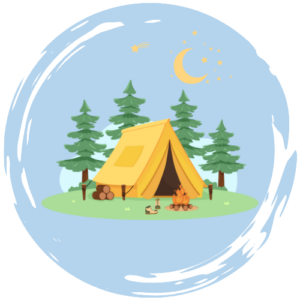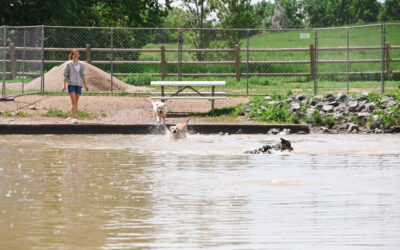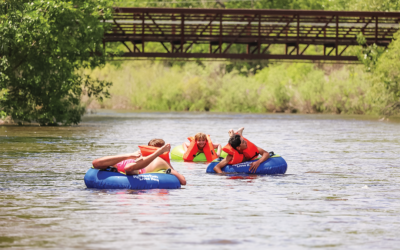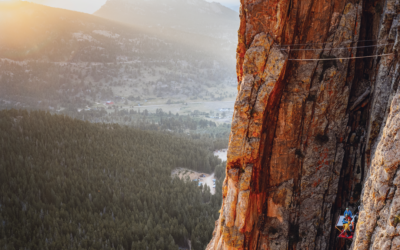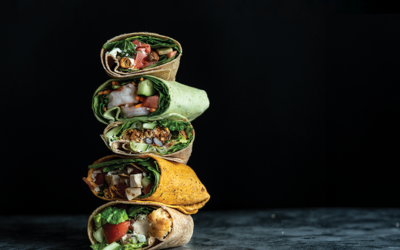Spring has a way of reconnecting humans with nature: We stop in our tracks to admire blooming tulips, take deeper breaths during afternoon rainstorms and awake to the chatter of birds outside our bedroom window. These long-awaited, fair-weather days not only remind us of the beauty all around us, but also our responsibility to take care of it.
With Earth Day approaching, now is the perfect time to assess how our daily decisions might negatively impact the environment. However, the first step to change those patterns is educating ourselves on why it matters, says Matt Tobler, owner and director of Blue Mountain Environmental Consulting, a natural resource management firm based in Fort Collins.
“Read something,” Tobler says. “Even if it’s a subscription to National Geographic, that helps to plant the seed of understanding our impact as a society. Without a fundamental understanding of natural sciences, all the stuff that comes out of the environmental industry is either regarded as partisan hype or gobbledygook. None of it makes sense, and we ask ourselves, ‘Why is this a high priority?'”
Understanding and mitigating our environmental impact is important, Tobler says, because as it currently stands, we will likely experience significant effects of climate change within the next 50 years. Those include everything from extreme weather events and mass migration to issues with food supply and agriculture, he says.
“Once all this environmental stuff moves into the front seat, we can’t change it anymore,” he says. “So the question is, ‘How do we take this from a concept that’s unimportant and peripheral to something that’s important but perhaps not, at the moment, central?'”

Volunteering and donating
Tobler recommends finding an environmental nonprofit to volunteer with or donate to, either on Earth Day or any other day of the year. Some of his favorites are The Nature Conservancy, Colorado Open Lands, Colorado Cattlemen’s Agricultural Land Trust, Northern Colorado Bird Alliance, Rocky Mountain Raptor Program, Northern Colorado Wildlife Center, Citizens’ Climate Lobby, Overland Mountain Bike Association and Bike Fort Collins.
He also points to Wildlands Restoration Volunteers, a local nonprofit that organizes thousands of volunteers annually to help with conservation projects across the state. Kevin Shuck, managing director of the organization, says there are roughly 30 projects coming up that still have slots for volunteers, including half and full days spent planting trees, cleaning up rivers, weeding invasive species and building trails. They also do weekend trips in the backcountry—Shuck calls them a “little nature getaway”—though many projects take place right here in Northern Colorado, like their willow planting days along the Big Thompson River.
“You’re actually getting out and doing something tangible, and you don’t have to have experience,” Shuck says. “We teach everything hands-on, and the logistics are taken care of. We really try to create a nice, supportive environment for people to feel like they have what they need in order to make a difference.”
Shuck says volunteerism has declined in the U.S. since the pandemic, which concerns him because so many of the organizations that are doing good work rely heavily on volunteers for support. On top of that, public land agencies are chronically underfunded, he says, so the need for volunteers is greater than ever.
“It’s really up to individuals to decide, ‘This is important, and it’s something I can do, so I’m going to step up and be a part of it,'” he says.
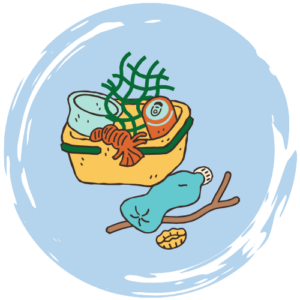
Picking up trash
Some of the Wildlands Restoration Volunteers’ projects involve picking up trash along the rivers, which is something anyone can do at any time, Shuck says. He suggests bringing a small trash bag with you when you go on walks so that you can pick up any discarded wrappers, bottles and little bits of trash that hundreds of people have walked by.
“Just do your little part to keep our neighborhoods, towns and wild places clean,” he says. “Trash detracts from the experience of being outside.”
A big problem along the rivers is tangled fishing line, old hooks and lead weights, Tobler says. He believes that picking up trash while you’re out enjoying nature can help you take pride in where you live. In fact, he recently spent part of a family vacation in Oregon picking up trash along the beach.
“The beaches are breathtakingly beautiful, but there was rope, Styrofoam…. One of the most fulfilling days I had the whole year was filling a dumpster with this material,” he says.
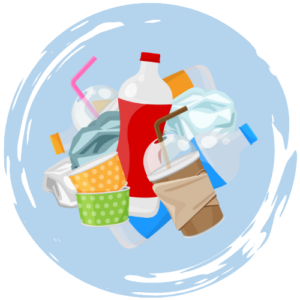
Reducing plastic use
When plastic materials end up as litter, they break down and form microplastics that stay in our environment, Shuck says. That’s a big reason why he and Tobler recommend not only picking up trash when you see it, but also reducing your plastic use as a consumer.
“We, as a society, need to be mindful of how many things we purchase that are embodied in plastic,” Tobler says. “There is no end life to plastic materials; they only break up into smaller parts, and they pass into our system and accumulate in our bodies.”
Now microplastics are so broadly distributed in the ecosystem that they’re everywhere, Tobler says. Still, making conscious choices about what we’re purchasing, say, at the grocery store, can help to reduce the amount of microplastics that end up in our environment.
“If you go to the grocery store, and you want orange juice, there’s going to be a paper carton alternative,” he says. “Also, switch out your plastic water bottle for something that’s metal because the phthalates—or plastic softeners—leach out of the plastic into your drinking water.”

Planting trees and native plants
“The best time to plant a tree was 20 years ago, and the second best time is right now,” Tobler says, noting that trees sequester (or capture and store) atmospheric carbon dioxide, a harmful greenhouse gas.
Wildlands Restoration Volunteers hosts planting days in wild areas, but for those who are looking to plant a tree in their yard, Shuck recommends several native species. Among them are Rocky Mountain maples, which are smaller trees with leaves that turn a beautiful yellow in the fall, and ponderosa pines, which are easy to grow and thrive on the plains.
Shuck also encourages the use of native plants in landscaping, such as bee balm, coneflower and pasque flower (a spring bloomer).
“Planting any native species is a big way people can make a difference,” he says. “They’re waterwise, and they support local pollinators.”
This is especially important because insect populations are declining, Tobler says, and insects serve as an essential food source for birds. A 2019 study found that a quarter of the bird population in North America had been lost since 1970, and they are still on that trajectory, according to the National Audubon Society.
“Birds are an indicator of ecosystem health, so the numbers are shocking,” Tobler says. “That’s why reducing our use of insecticides, pesticides and herbicides is a big deal, and hand-pulling weeds is preferable.”

Making eco-efficient home upgrades
There are a ton of easy, eco-friendly upgrades that can be made to a home, Tobler says, like replacing standard light bulbs with LEDs, installing water-efficient fixtures and insulating the attic to conserve energy. Each city has resources for people who are looking for guidance, including information about rebates for energy efficiency. The City of Fort Collins even has incentives for those who want to swap out their gas-powered mower for an electric one, Tobler says.
“Catios,” or outdoor cat enclosures, are a good option for cat owners who want their furry friends to enjoy nondestructive time outside. Outdoor cats kill approximately 2.4 billion birds every year in the U.S. (plus other animals), according to the American Bird Conservancy.
“Cats are one of the most destructive feral species on the planet,” Tobler says. “Keep your cat indoors or put them on a leash because they’re very disruptive to the ecosystem.”

Upcycling and reusing items
Rather than buying everything brand new, Tobler and Shuck suggest taking inventory of what you already have so you don’t end up with an excess of things that will find their way into the landfill. For Shuck, that has meant using old tent stakes as garden stakes and a discarded box as a stand for his computer monitor.
“I think the box was originally filled with chocolates, and I noticed that someone put it in the trash after we put the goodies out on the table for everyone,” he says. “I realized, ‘That’s a perfectly fine box. I’m going to take it out of the trash and find another use for it.’ Here it is a couple years later, still supporting my monitor.”
Getting outside
Spending time outdoors reconnects people with the wild, Tobler says, and when people experience a love of nature, they care more about environmental issues. That’s why Tobler encourages everyone to visit a park or protected area and just enjoy themselves from time to time.
“Make it fun for everybody, and have it fit into what your family likes to do,” he says. “Having a desire for recreation that occurs in natural spaces gets people focused on their environment.”
Whether it’s an afternoon spent tossing a Frisbee or riding a bike, Tobler says any recreational outdoor activity is beneficial. And with Fort Collins’ 285-plus miles of trails (and even more if you add other parts of Northern Colorado), many find biking to be an enjoyable and eco-friendly alternative to driving a car.
“It’s all about how we govern ourselves and the choices we make throughout the day, throughout the year and throughout our lives,” Tobler says. “It’s about what we’re doing with our time and energy, where we’re investing money, what we’re purchasing and what we’re bringing into our life.”
Taking care of the environment is a year-round effort, Shuck adds. But for many, Earth Day is a good reminder.
“I’d encourage people to make a resolution that they’re going to get out there and do something and give back,” he says. “We should all say, ‘These are things I enjoy and value, and I want to be a part of the solution to make them better.'”



